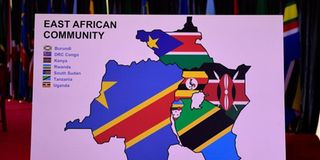Prime
Expanded EAC requires investment in connecting infrastructure

What you need to know:
- It will require addressing the historically systemic barriers to social and economic interaction among business people and citizens within the region
In an uncommon convening of high level East African Community (EAC) meeting by heads of states, the Democratic Republic of Congo (DRC) was admitted to the EAC on March 29, 2022, bringing a consolidated membership to seven comprising Kenya, Uganda, Tanzania, Rwanda, Burundi, South Sudan and DRC. Celebrations were replete on different social media platforms, the most captivating of which I read that day observed that “we have finally connected the Indian ocean to the Atlantic Ocean” in one gigantic stroke of pen.
Yet transitioning from mere aspiration to real integration will require much more than political will from heads of states and the bureaucrats. It will require addressing the historically systemic barriers to social and economic interaction among business people and citizens within the region.
A recent article by the Economist has identified various types of non-tariff barriers that continue to forestall deepened trade among African countries.
These include delayed logistic clearance at border points ranging from as long as 242 hours in some countries to 4 hours in the EAC. Others that loom large across neighbouring countries has been connecting infrastructure.
Whereas there has been improvement in road network between some EAC neighbouring countries, road network is hardly the most efficient and effective means to facilitate movement of goods and people within the region.
One of the reasons why there is yet not as many people that move within the EAC states is because of long hours of travel between neighbouring countries. If an efficient railway system operated between these countries, it would certainly cut the travel time by half. The alternative efficient means of travel (air) is quite expensive, making it extremely limiting for people to move across the region.
Yet we know, at least from historiography of trade that business links are often borne out of increased interaction among people. But how can connecting infrastructure be developed?
Assuming governments can overcome complex land acquisition processes that often lead to delays in commissioning of such projects, the suggestion that is advanced by this article is the formation of regional based governments’ organisation that would coordinate collective state funding, undertake planning and implementation of infrastructure priority projects that seek to serve the rest of the region.
Here I imagine an organisation that implements energy projects, railway line and roads projects. The organisation would need to be insulated from countervailing local political dynamics to allow the technocrat, meritocratically and impersonally recruited from across different member states based on their competence rather than on concerns of regional balance, to undertake planning and implementation of such projects.
Such an arrangement would be central to ensure that projects are not delayed, affected and deprioritised by local national politics. Joint coordination in implementation of such projects would also offer EAC a real opportunity to consolidate regional expertise to delivery of joint projects.
This culture of collaborating on key projects can eventually spill over into other dimensions such as finance, data science as well as identification of opportunities for jointly harnessing talent and catapulting regional competitiveness and dealing with the rest of the world as a regional bloc rather as individual countries, which often tends to undermine regional collaboration. Finally, financing such projects would require agreement among member states on annual budgetary commitments to such projects depending on the countries’ capacity to contribute. Free-riding concerns often loom large here. But stronger economies such as Kenya, Uganda, DRC, should be willing to contribute more in order to facilitate take off of these key projects.
Therefore, to realise and drive actual integration will require serious strategic thinking and joint practical collaboration on solving the key non-tariff barriers that continue to obstruct the capacity of citizens to move unencumbered by concerns of costs within the region.
Increased movement and interaction of people within the region, may eventually increase the scale and scope of trade and may even finally put to bed the endemic problem of political instability that often undermines continuity of integration efforts.
Michael Butera Mugisha, PhD candidate at the London School of Economics and Political Science and an Assistant Lecturer at Makerere University.




